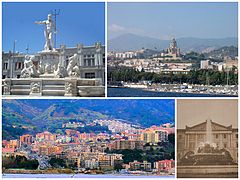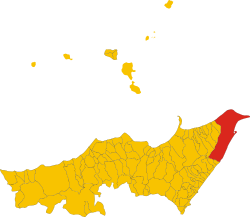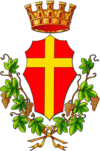Messina
| Messina | |||
|---|---|---|---|
| Comune | |||
| Metropolitan City of Messina | |||
 |
|||
|
|||
 Position of the commune in the Metropolitan City |
|||
| Location of Messina in Italy | |||
| Coordinates: 38°11′N 15°33′E / 38.183°N 15.550°ECoordinates: 38°11′N 15°33′E / 38.183°N 15.550°E | |||
| Country | Italy | ||
| Region | Sicily | ||
| Province / Metropolitan city | Messina (ME) | ||
| Government | |||
| • Mayor | Renato Accorinti | ||
| Area | |||
| • Total | 211.2 km2 (81.5 sq mi) | ||
| Elevation | 3 m (10 ft) | ||
| Population (31 January 2013)[1] | |||
| • Total | 238,026 city metro |
||
| Demonym(s) | Messinesi | ||
| Time zone | CET (UTC+1) | ||
| • Summer (DST) | CEST (UTC+2) | ||
| Postal code | 98100 | ||
| Dialing code | 090 | ||
| Patron saint | Madonna of the Letter | ||
| Saint day | June 3 | ||
| Website | Official website | ||
Messina (/məˈsiːnə/; Italian pronunciation: [mesˈsiːna] (![]() listen), Sicilian: Missina; Latin: Messana, Greek: Μεσσήνη) is the capital of the Italian Metropolitan City of Messina. It is the 3rd largest city on the island of Sicily, and the 13th largest city in Italy, with a population of more than 238,000[2] inhabitants in the city proper and about 650,000 in the Metropolitan City. It is located near the northeast corner of Sicily, at the Strait of Messina, opposite Villa San Giovanni on the mainland, and has close ties with Reggio Calabria.
listen), Sicilian: Missina; Latin: Messana, Greek: Μεσσήνη) is the capital of the Italian Metropolitan City of Messina. It is the 3rd largest city on the island of Sicily, and the 13th largest city in Italy, with a population of more than 238,000[2] inhabitants in the city proper and about 650,000 in the Metropolitan City. It is located near the northeast corner of Sicily, at the Strait of Messina, opposite Villa San Giovanni on the mainland, and has close ties with Reggio Calabria.
The city's main resources are its seaports (commercial and military shipyards), cruise tourism, commerce, and agriculture (wine production and cultivating lemons, oranges, mandarin oranges, and olives). The city has been a Roman Catholic Archdiocese and Archimandrite seat since 1548 and is home to a locally important international fair. The city has the University of Messina, founded in 1548 by Ignatius of Loyola.
Messina has a light rail system, Tranvia di Messina, that was opened on 3 April 2003. This line is 7.7 kilometres (4.8 mi) and links the city's central railway station with the city centre and harbour.
The city is home to a significant Greek-speaking minority, rooted in its history and officially recognised.[3]
Contents
History[edit]



Founded by Greek colonists in the 8th century BC, Messina was originally called Zancle (Greek: Ζάγκλη), from the Greek ζάγκλον meaning "scythe" because of the shape of its natural harbour (though a legend attributes the name to King Zanclus). A comune of its Metropolitan City, located at the southern entrance of the Strait of Messina, is to this day called 'Scaletta Zanclea'. In the early 5th century BC, Anaxilas of Rhegium renamed it Messene (Μεσσήνη) in honour of the Greek city Messene (See also List of traditional Greek place names). The city was sacked in 397 BC by the Carthaginians and then reconquered by Dionysius I of Syracuse.
In 288 BC the Mamertines seized the city by treachery, killing all the men and taking the women as their wives. The city became a base from which they ravaged the countryside, leading to a conflict with the expanding regional empire of Syracuse. Hiero II, tyrant of Syracuse, defeated the Mamertines near Mylae on the Longanus River and besieged Messina. Carthage assisted the Mamertines because of a long-standing conflict with Syracuse over dominance in Sicily. When Hiero attacked a second time in 264 BC, the Mamertines petitioned the Roman Republic for an alliance, hoping for more reliable protection. Although initially reluctant to assist lest it encourage other mercenary groups to mutiny, Rome was unwilling to see Carthaginian power spread further over Sicily and encroach on Italy. Rome therefore entered into an alliance with the Mamertines. In 264 BC, Roman troops were deployed to Sicily, the first time a Roman army acted outside the Italian Peninsula. At the end of the First Punic War it was a free city allied with Rome. In Roman times Messina, then known as Messana, had an important pharos (lighthouse). Messana was the base of Sextus Pompeius, during his war against Octavian.
After the fall of the Roman Empire, the city was successively ruled by Goths from 476, then by the Byzantine Empire in 535, by the Arabs in 842, and in 1061 by the Norman brothers Robert Guiscard and Roger Guiscard (later count Roger I of Sicily). In 1189 the English King Richard I, ("The Lionheart") stopped at Messina en route to the Holy Land and briefly occupied the city after a dispute over the dowry of his sister, who had been married to William the Good, King of Sicily
Messina may have been the harbour at which the Black Death entered Europe: the plague was brought by Genoese ships coming from Caffa in the Crimea. In 1548 St. Ignatius founded there the first Jesuit college in the world, which later gave birth to the Studium Generale (the current University of Messina).[citation needed]
The Christian ships that won the Battle of Lepanto (1571) left from Messina: the Spanish author Miguel de Cervantes, who took part in the battle, recovered for some time in the Grand Hospital. The city reached the peak of its splendour in the early 17th century, under Spanish domination: at the time it was one of the ten greatest cities in Europe. In 1674 the city rebelled against the foreign garrison. It managed to remain independent for some time, thanks to the help of the French king Louis XIV, but in 1678, with the Peace of Nijmegen, it was reconquered by the Spaniards and sacked: the university, the senate and all the privileges of autonomy it had enjoyed since the Roman times were abolished. A massive fortress was built by the occupants and Messina decayed steadily. In 1743, 48,000 died of plague in the city.[4]
In 1783, an earthquake devastated much of the city, and it took decades to rebuild and rekindle the cultural life of Messina. In 1847 it was one of the first cities in Italy where Risorgimento riots broke out. In 1848 it rebelled openly against the reigning Bourbons, but was heavily suppressed again. Only in 1860, after the Battle of Milazzo, the Garibaldine troops occupied the city. One of the main figures of the unification of Italy, Giuseppe Mazzini, was elected deputy at Messina in the general elections of 1866. Another earthquake of less intensity damaged the city on 16 November 1894. The city was almost entirely destroyed by an earthquake and associated tsunami on the morning of 28 December 1908, killing about 100,000 people and destroying most of the ancient architecture. The city was largely rebuilt in the following year. It incurred further damage from the massive Allied air bombardments of 1943. The city was awarded a Gold Medal for Military Valour and one for Civil Valour in memory of the event and the subsequent effort of reconstruction.[citation needed]
In June 1959, Messina was the location of the Messina Conference of Western European foreign ministers which led to the creation of the European Economic Community.[5]
Climate[edit]
| Climate data for Messina | |||||||||||||
|---|---|---|---|---|---|---|---|---|---|---|---|---|---|
| Month | Jan | Feb | Mar | Apr | May | Jun | Jul | Aug | Sep | Oct | Nov | Dec | Year |
| Record high °C (°F) | 24.6 (76.3) |
26.9 (80.4) |
32.0 (89.6) |
29.6 (85.3) |
33.6 (92.5) |
43.4 (110.1) |
43.6 (110.5) |
41.8 (107.2) |
40.5 (104.9) |
36.4 (97.5) |
29.2 (84.6) |
26.6 (79.9) |
43.6 (110.5) |
| Average high °C (°F) | 14.4 (57.9) |
14.7 (58.5) |
16.1 (61) |
18.3 (64.9) |
22.5 (72.5) |
26.8 (80.2) |
30.0 (86) |
30.5 (86.9) |
27.5 (81.5) |
23.2 (73.8) |
18.8 (65.8) |
15.8 (60.4) |
21.55 (70.78) |
| Daily mean °C (°F) | 12.3 (54.1) |
12.2 (54) |
13.5 (56.3) |
15.4 (59.7) |
19.5 (67.1) |
23.6 (74.5) |
26.7 (80.1) |
27.3 (81.1) |
24.5 (76.1) |
20.5 (68.9) |
16.4 (61.5) |
13.7 (56.7) |
18.8 (65.84) |
| Average low °C (°F) | 10.1 (50.2) |
9.8 (49.6) |
10.9 (51.6) |
12.5 (54.5) |
16.4 (61.5) |
20.4 (68.7) |
23.4 (74.1) |
24.2 (75.6) |
21.5 (70.7) |
17.8 (64) |
14.1 (57.4) |
11.6 (52.9) |
16.06 (60.9) |
| Record low °C (°F) | 0.2 (32.4) |
−0.1 (31.8) |
−0.2 (31.6) |
4.3 (39.7) |
7.5 (45.5) |
12.4 (54.3) |
15.3 (59.5) |
14.4 (57.9) |
12.5 (54.5) |
7.5 (45.5) |
5.1 (41.2) |
1.0 (33.8) |
−0.2 (31.6) |
| Average precipitation mm (inches) | 102.9 (4.051) |
100.2 (3.945) |
83.4 (3.283) |
68.3 (2.689) |
33.8 (1.331) |
12.7 (0.5) |
20.0 (0.787) |
25.6 (1.008) |
63.9 (2.516) |
113.7 (4.476) |
119.5 (4.705) |
102.9 (4.051) |
846.9 (33.342) |
| Average precipitation days (≥ 1.0 mm) | 10.6 | 9.8 | 8.6 | 8.5 | 3.9 | 1.9 | 2.0 | 2.5 | 5.6 | 8.5 | 11.0 | 10.9 | 83.8 |
| Average relative humidity (%) | 73 | 71 | 69 | 69 | 67 | 64 | 63 | 66 | 68 | 70 | 73 | 74 | 68.9 |
| Mean monthly sunshine hours | 114.7 | 130.0 | 170.5 | 207.0 | 257.3 | 294.0 | 331.7 | 306.9 | 240.0 | 189.1 | 138.0 | 111.6 | 2,490.8 |
| Source #1: Servizio Meteorologico (temperature and precipitation data 1971-2000);[6] Clima en Messina desde 1957 hasta 2013[7] | |||||||||||||
| Source #2: Messina Osservatorio Meteorologico (temperature records since 1909);[8] Servizio Meteorologico (relative humidity and sun data 1961-1990)[9] | |||||||||||||
Main sites[edit]
Religious architecture[edit]
| This section needs additional citations for verification. (April 2013) (Learn how and when to remove this template message) |

- The Cathedral (12th century), containing the remains of king Conrad, ruler of Germany and Sicily in the 13th century. The building had to be almost entirely rebuilt in 1919-20, following the devastating 1908 earthquake, and again in 1943, after a fire triggered by Allied bombings. The original Norman structure can be recognised in the apsidal area. The façade has three late Gothic portals, the central of which probably dates back to the early 15th century. The architrave is decorated with a sculpture of Christ Among the Evangelists and various representations of men, animals and plants. The tympanum dates back to 1468. The interior is organised in a nave and two equally long aisles divided by files of 28 columns. Some decorative elements belong the original building, although the mosaics in the apse are reconstructions. Tombs of illustrious men besides Conrad IV include those of Archbishops Palmer (died in 1195), Guidotto de Abbiate (14th century) and Antonio La Legname (16th century). Special interest is held by the Chapel of the Sacrament (late 16th century), with scenic decorations and 14th century mosaics. The bell tower holds one of the largest astronomical clocks in the world, built in 1933 by the Ungerer Company of Strasbourg. The belfry's mechanically-animated statues, which illustrate events from the civil and religious history of the city every day at noon, are a popular tourist attraction.
- The Sanctuary of Santa Maria del Carmelo (near the Courthouse), built in 1931, which contains a 17th-century statue of the Virgin Mary. See also Chiesa del Carmine.
- The Sanctuary of Montevergine, where the incorrupt body of Saint Eustochia Smeralda Calafato is preserved.
- The Church of the Annunziata dei Catalani (late 12th-13th century). Dating from the late Norman period, it was transformed in the 13th century when the nave was shortened and the façade added. It has a cylindrical apse and a high dome emerging from a high tambour. Noteworthy is the external decoration of the transept and the dome area, with a series of blind arches separated by small columns, clearly reflecting Arabic architectural influences.
- The Church of Santa Maria degli Alemanni (early 13th century), which was formerly a chapel of the Teutonic Knights. It is a rare example of pure Gothic architecture in Sicily, as is witnessed by the arched windows and shapely buttresses.
Civil and military architecture[edit]
- The Botanical Garden Pietro Castelli of the University of Messina.
- The Palazzo Calapaj, an example of 18th century Messinese architecture which survived until the 1908 earthquake.
- The Forte del Santissimo Salvatore, a 16th-century fort in the Port of Messina.
- The Forte Gonzaga, a 16th-century fort overlooking Messina.
- The Porta Grazia, 17th century gate of the "Real Cittadella di Messina", by Domenico Biundo and Antonio Amato, a fortress still existing in the harbour.
- The Pylon, built in 1957 together with a twin located across the Strait of Messina, to carry a 220 kV overhead power line bringing electric power to the island. At the time of their construction, the two electric pylons were the highest in the world. The power line has since been replaced by an underwater cable, but the pylon still stands as a freely accessible tourist attraction.
- The San Ranieri lighthouse, built in 1555.
Monuments[edit]
- The Fountain of Orion, located next to the Cathedral, built by Giovanni Angelo Montorsoli in 1547.
- The Fountain of Neptune, looking towards the harbour, built by Montorsoli in 1557.
- The Senatory Fountain, built in 1619.
- The Four Fountains, though only two elements of the four-cornered complex survive today.
Museum[edit]
- The Galleria d'Arte Contemporanea di Messina,[10] hosting notable paintings by Caravaggio[11] and Antonello da Messina.
Notable residents[edit]
- Antonello da Messina, major painter of the Renaissance (born 1430)
- Dicaearchus, Greek philosopher and mathematician (born 350 BC)
- Eustochia Smeralda Calafato, saint (born 1434)
- Francesco Maurolico, astronomer and mathematician (born 1494)
- Filippo Bonaffino (fl. 1623), Italian madrigal composer
- Filippo Juvarra, architect and highest exponent of the Baroque (born 1678)
- Annibale Maria Di Francia, saint (born 1851)
- Giuseppe Sergi, anthropologist (born 1841)
- Luigi Rizzo, naval officer and First World War hero (born 1887)
- Maria Grazia Cucinotta, actress (born 1968)
- Antonino Fogliani, music conductor (born 1976)
- Vincenzo Nibali, cyclist (born 1984)
- Agata C. M. Scolgio, a.k.a. Tina Scala, actress (born July 16, 1934) sister to Gia Scala Tina appeared in Midnight Cowboy
Literary references[edit]
Numerous writers set their works in Messina, including:
- Plutarch - The Life of Pompey (40 BC?)
- Giovanni Boccaccio - Decameron IV day V novel, Lisabetta da Messina - IV day IV Novel, Gerbino ed Elissa (1351)
- Matteo Bandello - Novelliere First Part, novel XXII (1554)
- William Shakespeare - Much Ado about Nothing (1598) and Antony and Cleopatra (1607)
- Molière - L'Etourdi ou Les Contre-temps (1654)
- Friedrich Schiller - Die Braut von Messina (The Bride of Messina, 1803)
- Silvio Pellico - Eufemio da Messina (1818)
- Friedrich Nietzsche - Idyllen aus Messina (Idylls from Messina, 1882)
- Giovanni Pascoli - poem L'Aquilone (1904)
- Elio Vittorini - Le donne di Messina (Women of Messina, 1949) and Conversazione in Sicilia (Conversations in Sicily, 1941)
- Stefano D'Arrigo - Horcynus Orca (1975)
- Julien Green - Demain n'existe pas (1985)
See also[edit]
- A.C.R. Messina
- International Rally of Messina
- Messina Centrale railway station
- Messina Grand Prix held between 1959 and 1961
- Strait of Messina Bridge
- Torre Faro 224 metres tall lattice tower
Notes[edit]
- ^ Data from ISTAT
- ^ Population of Messina, Italy Geonames Geographical database
- ^ Delimiting the territory of the Greek linguistic minority of Messina
- ^ "Epidemiology of the Black Death and Successive Waves of Plague" by Samuel K Cohn JR. Medical History.
- ^ "''The Messina Declaration 1955'' final document of ''The Conference of Messina'' 1 to 3 June 1955 - birth of the European Union". Eu-history.leidenuniv.nl. Retrieved 5 April 2011.
- ^ "MESSINA" (PDF). Servizio Meteorologico. Retrieved 13 October 2012.
- ^ "Messina". Retrieved 8 February 2013.
- ^ "Messina Osservatorio Meteorologico". Servizio Meteorologico dell’Aeronautica Militare. Retrieved 17 February 2014.
- ^ "MESSINA". Servizio Meteorologico. Retrieved 13 October 2012.
- ^ http://www.regione.sicilia.it/bbccaa/Dirbenicult/musei/musei2/engarmessina.htm
- ^ "Regione Siciliana Assessorato Beni Culturali". Regione Siciliana. Retrieved 5 April 2011.
Further reading[edit]
- "Messina", Italy : Handbook for Travellers: Third Part, Southern Italy, Sicily, Karl Baedeker, 1867, OCLC 4158305
- "Messina", Southern Italy and Sicily (15th ed.), Leipzig: Karl Baedeker, 1908
External links[edit]
| Wikimedia Commons has media related to Messina. |
| Wikivoyage has a travel guide for Messina. |
| Wikisource has the text of the 1879 American Cyclopædia article Messina. |
- Official website (Italian)
- Cities and towns in Sicily
- Municipalities of the Province of Messina
- Messina
- Populated coastal places in Italy
- Cumaean colonies
- Euboean colonies of Magna Graecia
- Mediterranean port cities and towns in Italy
- Populated places established in the 8th century BC
- 8th-century BC establishments in Italy
- University towns in Italy








